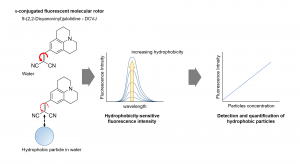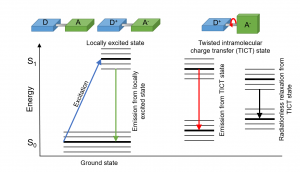Fluorescence molecular rotors for particles sensing
Fluorescent molecular rotors (FMRs) can act as hydrophobicity and viscosity probes in various media. FMRs are π‐conjugated fluorescent molecules, termed as “fluorophores”. The general chemical structure of FMRs and their working principle is illustrated in the figure below. Fluorescence intensity varies with the degree of intramolecular rotation of the rotators incorporated in the π‐conjugated bridge, which are affected by environmental viscosity or hydrophobicity. The GR-CEL is currently working on the develpment of methods to detect and quantify hydrophobic particles using FMRs.

